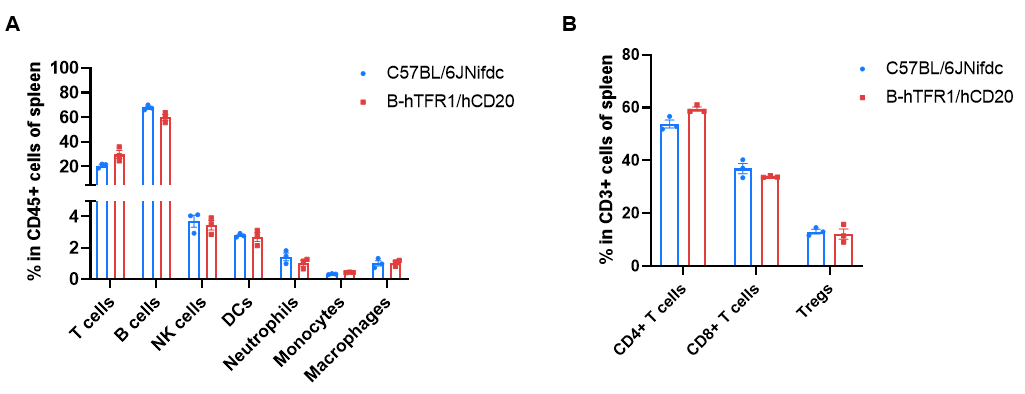


C57BL/6-Tfrctm1(TFRC)Bcgen Ms4a1tm2(MS4A1)Bcgen/Bcgen • 113638
| Product name | B-hTFR1/hCD20 mice |
|---|---|
| Catalog number | 113638 |
| Strain name | C57BL/6-Tfrctm1(TFRC)Bcgen Ms4a1tm2(MS4A1)Bcgen/Bcgen |
| Strain background | C57BL/6 |
| NCBI gene ID | 22042, 931 |
| Aliases | CD71, IMD46, T9, TFR, TFR1, TR, TRFR, p90;B1, Bp35, CD20, CVID5, FMC7, LEU-16, S7; |
Background:
Targeting strategy:
Verification:
Application:
Gene targeting strategy for B-hTFR1/hCD20 mice.
The exons 4-19 of mouse Tfr1 gene that encode extracellular domain are replaced by human counterparts in B-hTFR1/hCD20 mice. The genomic region of mouse Tfr1 gene that encodes cytoplasmic portion is retained. The promoter, 5’UTR and 3’UTR region of the mouse gene are also retained. The chimeric TFR1 expression is driven by endogenous mouse Tfr1 promoter, while mouse Tfr1 gene transcription and translation will be disrupted.
The exons 2-7 of mouse Cd20 gene that encode the whole molecule (ATG to STOP codon) are replaced by human counterparts in B-hTFR1/hCD20 mice.

Strain specific CD20 expression analysis in wild-type C57BL/6JNifdc and homozygous B-hTFR1/hCD20 mice by flow cytometry. Splenocytes were collected from wild-type C57BL/6JNifdc (+/+) and homozygous B-hTFR1/hCD20 mice (H/H, H/H) and analyzed by flow cytometry with anti-mouse CD20 antibody (Biolegend, 152107) and anti-human CD20 antibody (Biolegend, 302305). mCD20 was only detectable in wild-type C57BL/6JNifdc mice, and hCD20 was exclusively detectable in homozygous mice but not in wild-type mice.

Strain specific TFR1 expression analysis in wild-type C57BL/6JNifdc and homozygous B-hTFR1/hCD20 mice by flow cytometry. Bone marrow cells were collected from wild-type C57BL/6JNifdc (+/+) and homozygous B-hTFR1/hCD20 mice (H/H, H/H) and analyzed by flow cytometry with anti-mouse TFR1 antibody (Biolegend, 113808) and anti-human CD20 antibody (Biolegend, 334108). mTFR1 was only detectable in wild-type C57BL/6JNifdc mice, and hTFR1 was exclusively detectable in homozygous mice but not in wild-type mice.

Frequency of leukocyte subpopulations in spleen by flow cytometry. Splenocytes were isolated from wild-type C57BL/6JNifdc mice (male, n=3, 10-week-old) and homozygous B-hTFR1/hCD20 mice (male, n=3, 10-week-old). A. Flow cytometry analysis of the splenocytes was performed to assess the frequency of leukocyte subpopulations. B. Frequency of T cell subpopulations. Percentages of T cells, B cells, NK cells, DCs, neutrophils, monocytes, macrophages, CD4+ T cells, CD8+ T cells and Tregs in B-hTFR1/hCD20 mice were similar to those in C57BL/6JNifdc mice. The frequency of leukocyte subpopulations in lymph nodes and blood of B-hTFR1/hCD20 mice were also comparable to wild-type C57BL/6JNifdc mice (Data not shown). Values are expressed as mean ± SEM. Significance was determined by two-way ANOVA test. *P < 0.05, **P < 0.01, ***p < 0.001.